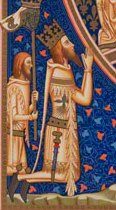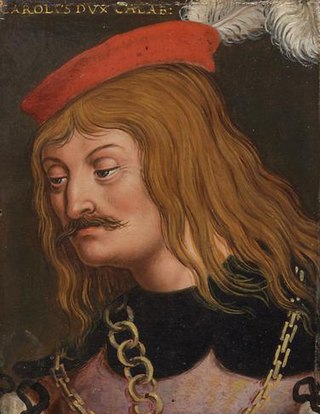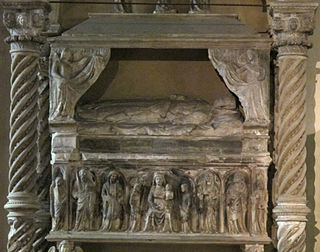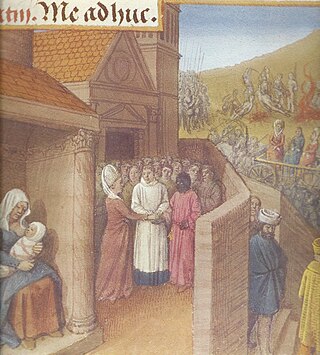
Giovanni Boccaccio was an Italian writer, poet, correspondent of Petrarch, and an important Renaissance humanist. Born in the town of Certaldo, he became so well known as a writer that he was sometimes simply known as "the Certaldese" and one of the most important figures in the European literary panorama of the fourteenth century. Some scholars define him as the greatest European prose writer of his time, a versatile writer who amalgamated different literary trends and genres, making them converge in original works, thanks to a creative activity exercised under the banner of experimentalism.

Robert of Anjou, known as Robert the Wise, was King of Naples, titular King of Jerusalem and Count of Provence and Forcalquier from 1309 to 1343, the central figure of Italian politics of his time. He was the third son of King Charles II of Naples and Mary of Hungary, and during his father's lifetime he was styled Duke of Calabria (1296–1309).

Joanna I, also known as Johanna I, was Queen of Naples, and Countess of Provence and Forcalquier from 1343 to 1382; she was also Princess of Achaea from 1373 to 1381.

Charles the Small or Charles of Durazzo was King of Naples and the titular King of Jerusalem from 1382 to 1386 as Charles III, and King of Hungary from 1385 to 1386 as Charles II. In 1381, Charles created the chivalric Order of the Ship. In 1383, he succeeded to the Principality of Achaea on the death of James of Baux.

Ladislaus the Magnanimous was King of Naples from 1386 until his death and an unsuccessful claimant to the kingdoms of Hungary and Croatia. Ladislaus was a skilled political and military leader, protector and controller of Pope Innocent VII; however, he earned a bad reputation concerning his personal life. He profited from disorder throughout Italy to greatly expand his kingdom and his power, appropriating much of the Papal States to his own use. He was the last male of the Capetian House of Anjou.

Louis I, also known as Louis of Taranto, was a member of the Capetian House of Anjou who reigned as King of Naples, Count of Provence and Forcalquier, and Prince of Taranto.

Alfonso II was Duke of Calabria and ruled as King of Naples from 25 January 1494 to 23 January 1495. He was a soldier and a patron of Renaissance architecture and the arts.

Giovanni Antonio (Giannantonio) Orsini del Balzo was a southern Italian nobleman and military leader; he was Prince of Taranto, Duke of Bari, Count of Lecce, Acerra, Soleto and Conversano, as well as Count of Matera (1433–63) and of Ugento (1453–63).
Raimondo Orsini del Balzo was a nobleman from the Kingdom of Naples. He was Count of Soleto (1382), Prince of Taranto (1399–1406), Duke of Bari, Grand Constable of the Kingdom of Naples, Gonfalonier of the Holy Roman Church. He was a member of the influential Orsini family of Rome. Although he is considered one of the most important people in the history of southern Italy, relatively little is known about his life.
Bartholomew "Tristan" de Clermont-Lodève, Count of Copertino, was a French-born knight who married Catherine Orsini del Balzo, youngest daughter of Mary of Enghien and Raimondo Orsini del Balzo, Prince of Taranto. He was the father of Isabella of Clermont, Princess of Taranto, the first consort of King Ferdinand I of Naples.

Andrew, Duke of Calabria was the first husband of Joanna I of Naples, and a son of Charles I of Hungary and brother of Louis I of Hungary.

Squillace is an ancient town and comune in the Province of Catanzaro, part of Calabria, Southern Italy.

Charles, Duke of Calabria, was the Duke of Calabria from 1309 until his death. Upon his father's elevation as King of Naples, he was made vicar-general of Naples and duke of Calabria He was elected as signore by the city of Florence in 1326. Charles died on 9 November 1328 in Naples.

Sancia of Majorca, also known as Sancha, was Queen of Naples from 1309 until 1343 as the wife of Robert the Wise. She served as regent of Naples during the minority of her stepgrandaughter, Joanna I of Naples, from 1343 until 1344.

The Capetian House of Anjou, or House of Anjou-Sicily, was a royal house and cadet branch of the direct French House of Capet, part of the Capetian dynasty. It is one of three separate royal houses referred to as Angevin, meaning "from Anjou" in France. Founded by Charles I of Anjou, the youngest son of Louis VIII of France, the Capetian king first ruled the Kingdom of Sicily during the 13th century. The War of the Sicilian Vespers later forced him out of the island of Sicily, which left him with the southern half of the Italian Peninsula, the Kingdom of Naples. The house and its various branches would go on to influence much of the history of Southern and Central Europe during the Middle Ages until it became extinct in 1435.

Maria of Calabria, Countess of Alba, was a Neapolitan princess of the Capetian House of Anjou whose descendants inherited the crown of Naples following the death of her older sister, Queen Joanna I.

The Neapolitan campaigns of Louis the Great, also called the Neapolitan Adventure, was a war between the Kingdom of Hungary, led by Louis the Great, and the Kingdom of Naples. It was fought from 1347 until 1352.
Agnes of Périgord was Duchess consort of Durazzo, through her marriage to John of Gravina, Duke of Durazzo, who was also the ruler of the Kingdom of Albania. Although Agnes was never styled as Queen consort, she became politically influential. Following the death of Robert, King of Naples in 1343, she organised a marriage for her eldest son to Robert's granddaughter, who was second-in-line to the Neapolitan throne. Agnes's ambition was to bring her family closer to the line of succession.

Philippa of Catania, also known Philippa the Catanian or Filippa Catanese, was a Sicilian woman of low birth who became an influential figure in the royal court of the Kingdom of Naples.

John (I) Drugeth was an influential Neapolitan–Hungarian baron, an early member of the powerful Drugeth family. He was a confidant of the Capetian House of Anjou since his childhood. While his younger brother Philip escorted his lord, the young pretender Charles of Anjou to the Kingdom of Hungary, John entered the service of Clementia, Queen consort of France and Navarre.

















